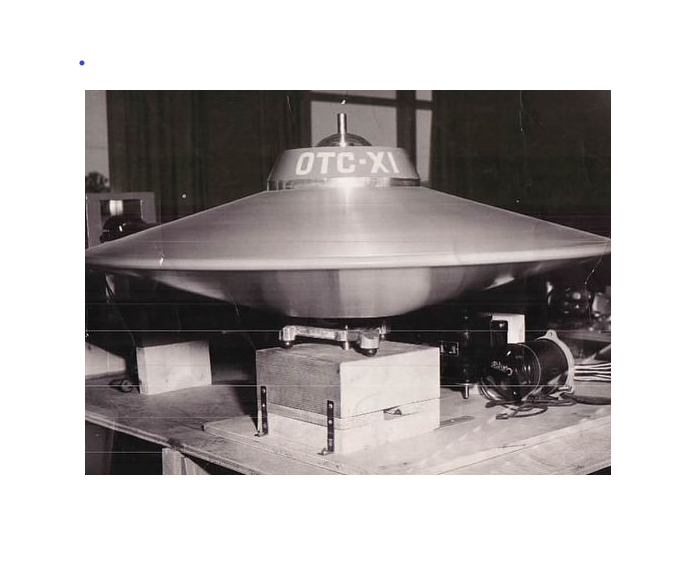Otis Carr's Craft

Otis Carr
1. Device composed of a platform that rotates in direct rotation (clockwise) together with the central battery (under the cabin) where the six capacitor plates are equally spaced and interspersed with the six regenerating accumulators (Utron devices) that rotate in counter rotation (counterclockwise).
2. Device composed of a platform fixed to the outer hull of the disc, which rotates in counter rotation (counterclockwise) together with twelve electromagnets equally spaced and distributed in the external perimeter.
3. Stationary device composed of the central cabin where the crew members are housed, fixed to the central axis of the ship where the lower support in the form of a tripod is attached and by which, through bearings, it forms a single set with the first two parts. While the internal platform, which has the six Utron regenerating accumulators, the central accumulator and the six capacitor plates, rotates in one direction, the external platform, which has the twelve electromagnets, rotates in the opposite rotation. The cabin, located at the top and center of the rotating mechanism, remains stationary due to the various coupling bearings. As stated by Carr: “We have this cabin as the center of the craft and the battery below the cabin and the electromagnets are the total outside of the circular foil. The shaft of the accumulator goes through the cabin and there is a bearing. Now, just as this stays stationary when this is rotated, so will the cabin because there are two rotating forces. You have the clockwise rotation of the accumulator, the capacitor plates, the generative coils, you have a counter-rotation of the entire circular area of the craft, the larger diameter which houses the electromagnets; therefore, when you have rotation in both directions, the cabin itself is like a bearing and extension of the shaft. We've built models and proved this is correct.”
To start the rotation movement of the motor, it is necessary to create a flow of electric current through the set of coils distributed on the periphery of the craft. As stated by Carr: “We have a tremendous spin here. An electric motor operates the same way. You set up an electromotive force inside a magnetic field and you get rotation. So what we actually have here is an improved electrical motor which in itself is a circular device, and we say we make energy out of the air, from another dimension. To clear your analogy up also, we would like to demonstrate the fact that this earth itself is literally a spacecraft demonstrating what we're talking about; it's rotating and orbiting at a certain constant speed with a magnetic field and it is in itself a spacecraft. … They (the coils) individually operate by circuit breakers and the first motion begins to start a repetition. The same we have in a motor that has the opposite of a commutator, which is an accumulation of contact points where each coil is energized as the current flows through this coil. Then this starts the motion, the repetition of this motion brings the whole motor into phase in the same sense our accumulator and magnets become speeded up and the circuits are made and broken as they rotate.”
When asked if the central battery set activates the electromagnets in the outer perimeter, and it is recharged by them, Carr replied: “This is true. We do this by contacting this lead wire from the positive and negative poles of these batteries to the electromagnets and then we have circuit breakers from these electromagnets and we have counter-rotation. These electromagnets will rotate counter-clockwise while the internal area is rotating clockwise. … The coils of wire inside the ring (ferromagnetic core) are regenerative coils; they are electromotive force coils and they assist in regenerating the battery, because they are loops of wire brought through a magnetic field which sets up an electromotive force. These others are capacitor plates. These are also activated by the central power core, but these plates; which can accept a very high charge in neutral conductance, also through the process of ionization utilize atmospheric electricity.”
Figure 4: Central axis bearing system
Insert drawing which depicts explanation.
Julio Gobbi continues to explain the control area. The central cabin is coupled to the two moving platforms, which rotate in direct rotation and in opposite rotation, through bearings mounted on the central axis of the cabin. These allow free movement of the moving parts while the central cabin remains stationary. The central battery pack rotates in direct rotation just below the cabin and is coupled by bearings mounted on the central axis. On its circular platform, the six Utron devices that rotate in counter rotation are mounted on bearings.
Insert illustration - Diagram 5
As I have studied Otis Carr’s ship, I might entertain a different perspective regarding Julio Gobbi’s mention of Otis Carr’s ship having fins on its outer shell to act as turbine induced aerodynamics.
Utron devices that rotate in counter rotation have fins that force their rotation like a turbine. This occurs when the central battery is put to spin, therefore, after a certain rotation, they work as energy generators by the same principle as the Faraday disk. They have a coil of enameled copper wire on their outer surface which produce a magnetic field that interacts with the electromagnets that rotate together with the hull of the craft in counter rotation. Initially, the electromagnets are powered by the central battery to rotate the battery platform as a motor in direct rotation. After a certain speed, the six Utrons produce enough magnetic energy to feed the central battery through its passage inside the air gap of the electromagnets.
In the third chapter of Julio Gobbi’s paper, he explains how the craft works. According to Carr, when two electrically charged bodies rotate in opposite directions on the same axis, the effect is to create a gravitational center that makes the craft independent of external gravitational forces: "Any vehicle accelerated to an axis rotation relative to its attractive inertial mass, immediately becomes activated by free-space-energy and acts as an independent force… We have shown that a charged body, accelerated to an axis rotation relative to this attractive inertial mass, indicates polarity in a given direction. The dip-needle points, say, up toward the top of the body. But mount this while rotating body (with its spindle) on another platform and rotate this platform on a spindle, then if the counter-rotation is greater than the inertial forward rotation of the body, a dip-needle on the second platform will point down while the first dip-needle points up, indicating complete relativity of polarity. When the exact counter-rotation matches the forward rotation the body loses its polarity entirely and immediately becomes activated by free-energy (tensor stresses in space) and acts as an independent force… The above-described assembly of counter-rotating charged masses becomes weightless and will escape the immediate attraction of gravitational forces…"
Carr uses an internal platform rotating in direct rotation and places several devices in counter-rotation with its axes fixed by bearings on this first platform. There are six counter-rotating devices, equally spaced along the perimeter of the internal platform and are called Utron regenerative accumulators. There is another external platform that rotates in counter-rotation, as opposed to the first platform, with twelve electromagnets that produce electrical energy during the passage of the Utrons in their air gaps, when the system works as a regenerative generator.
This second external platform rotating in counter-rotation aims to compensate for the rotation of the first internal platform and keep the central cabin stationary. The fact is that the internal platform works like a rotor, while the external platform works like a stator (armature). In another statement by Carr, we can confirm that to create an artificial gravity inside the craft, as well as to keep the central cabin stationary, it is necessary to rotate two systems in opposite rotation: “Yes, this is the beginning of an answer to your question: we have capacitor plates and electromagnets as a part of this system. Now, this is counter-rotating; the electromagnets rotate in one direction, and the batteries rotate in another. The capacitor plates rotate in conjunction with the battery so that we have a clockwise and counterclockwise rotation. Now the third system is the cabin that keeps the crew. This does not rotate; it is fixed due to the fact that the two bodies are rotating clockwise and counterclockwise. Therefore the system causes the craft to escape from the gravity pull. The craft itself due to this system still has internal gravity because it still has the same weight that it had in the beginning.”
As we can see, one of the functions of Utron devices and electromagnets is to make the system work like a motor, where the rotor and stator (armature) rotate in opposite rotation freely, which keeps the cabin stationary in the center. The switching of the electromagnets is done in a similar way to the present brushed motors and the supply of this “motor” is done by the central battery. However, switching the electromagnets also allows the energy regeneration of the batteries, when the system reaches a minimum rotation that allows the rotor (where the Utron accumulators are) and the stator (where the electromagnets are) to function as a generator. We can describe the central Utron as an energized rotor or, in other words, as a rotor that contains its own battery in motion and that is also capable of continually re-energizing itself. Otis Carr knew that bodies in high rotation create a gravitational field in the direction of the angular velocity vector, parallel to the spin axis. This principle was demonstrated in the chapter Gravitational Neutralization of the article Inertial Field [3], by analogy to the balance of forces that keeps a satellite in orbit around the planet. This gravitational neutralization was further studied in the section Gravitational Potential Neutralization in the article EM-GI Propulsion Systems [4]. We saw that when an object is in high rotation, it is possible to overcome the planet's gravitational field force, and we performed calculations that allow quantifying this phenomenon, known as the gyroscopic effect. This effect explains why, when asked about the square shape of the Utrons, Carr replied: “Dimensionally it is; it is square in these dimensions and when this rotation starts and builds up to a certain velocity, this form is very important because we have the total equation of action and reaction. Now this is done by a system of coil winding wherein we start at a point, expand to an equator, and continue our winding down to a point. With this physical expansion and contraction, is an electromagnetic field. Gravity enters the picture in the form of this relative rotation. When the relative rotation – inertial effective mass –, it's a matter of dimension. So that is the earth, say, is 8,000 miles in diameter, we know its fixed rotation is 1 in 24 hours. If we were 1 mile in diameter its rotation would be 8,000 in 24 hours. And by the same system, our 45-foot craft has a rotation of 580 rpm and when it reaches this rotation it is totally independent of its inertial attractive mass, in an electromagnetic field. …
This model was spun at 40,000 rpm and when it did it set a pressure pattern of 1,000 tons; the horsepower reading was a little over 700. Six engineers checked this out. Now the relative rotation of this model would be about 68,000 rpm, and when it reaches this rotation, it would immediately take off.”
